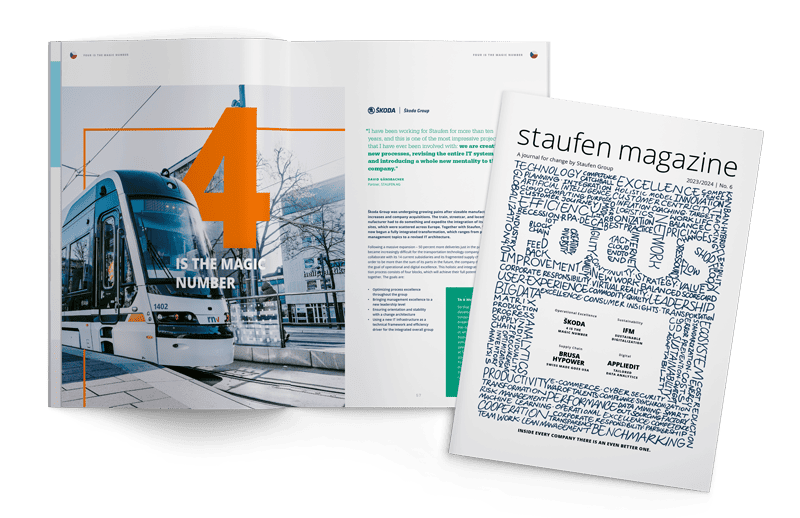
Anyone who wants to know how the digital pulse of the economy is beating has a very profound source in Oliver Erb. As Senior Vice President of Celonis at the world market leader for process mining, he is responsible for sales in the DACH region. According to Erb, digitization is leading to ever shorter innovation cycles and is therefore increasing the pressure on companies to constantly develop their processes and business models. His conclusion: “If a company does not want to be left behind, there is no alternative to consistent digitization!”
A large part of the economy already sees it the same way. According to the current Staufen study “Future Industry”, almost every second company has started new digitization projects despite the recent weakening of the economy. Above all, they want to increase efficiency (86 percent), bring more transparency to their processes (75 percent) and reduce costs (57 percent). Oliver Erb confirms: “There are pioneers who are already extremely far, but also companies that have a lot of catching up to do.”
Recently, the public got the impression that without revolution and disruption in the area of digitalization, nothing will happen. It is often said that those who do not introduce digital business models now will soon disappear from the market. The reality is probably not that radical after all. “Most companies rely on evolutionary innovations and are also successful with them,” reports Celonis manager Erb from the customer front.

Oliver Erb
Senior Vice President
CELONIS SE

AI IS CURRENTLY SOLVING SIMPLE TASKS SURPRISINGLY WELL, BUT NO COMPLEX ONES. HUMANS ARE ESSENTIAL AS CONTROL BODIES.
Oliver Erb
Senior Vice President, CELONIS SE
From an individual project to a digital strategy
Nevertheless, this is no reason for the industry to rest on its laurels. The digital pioneers in particular are putting pressure on other companies. If you want to continue doing business with them, you also have to be digital. The same applies here again: the companies have definitely recognized this and have therefore started many pilot projects. But precisely this – to put it bluntly – digital activism can become a problem. “Many companies have difficulties moving from scattered individual projects to large strategic initiatives,” says digitization expert Erb. He recommends two approaches: working with experienced partners and using the right technologies.
Both are closely related, because the development speed of the required technologies is high. It is not easy, especially for medium-sized companies, to stay on an equal footing. That is why partnerships with specialists or teams of experts, such as those regularly formed by Celonis together with Staufen, are essential. The second point is the variety of technologies. It is not enough to simply introduce software. Rather, it is crucial to bet on the right, i.e. tailor-made horse.
For example on data analysis: “From our point of view, the availability of data down to the machine level and its aggregation and analysis are the major accelerators of digitization in industry,” emphasizes Oliver Erb. This helps many companies to increase the efficiency of their processes and value-added chains. This approach is often criticized because it primarily optimizes and thus preserves existing business models. Much is reminiscent of the criticism leveled at the German automotive industry, which for many has been too hesitant to move towards electromobility for a long time.
Digital thinking leads to innovations
But the traditional industrial companies are in a predicament. They have to keep their current business as long as possible because it finances innovations and investments. At the same time, they have to work on new business models in order to be future-proof. That’s why companies don’t like revolutionary – from their point of view hasty – changes, not even in digitalization. “The projects are often tentative: You know that you have to do something, but you don’t know how to really get the best out of it,” says Gero Bockelmann, smart factory expert at drive specialist SEW-EURODRIVE, a pioneer in digitization and Industry 4.0. “For this reason, many are starting to increase efficiency.” Even if the really big advantages of digitization would undoubtedly only come with alternative business models and a changed way of thinking. “In the course of digitization, however, all employees are beginning to think more and more digitally. This, in turn, has an impact on the development of the entire organization.” The consequence of this ever-increasing digital thinking is the gradual development within companies towards digital business models. “Of course, the companies have to proceed strategically,” adds Oliver Erb from Celonis. “However, you should always keep an eye on rapid implementation and create real innovations.”
But: where do these innovations come from? Again, partnerships can make the difference. On the one hand, customers are an excellent inspiration for innovations. They usually know best what really helps them. But there is a second source for new products, services and business models: the universities and colleges. Cooperation with university-related institutions such as the Fraunhofer Institutes is also a decisive factor in driving digital change forward. Targeted programs and partnerships with universities and colleges ensure a supply of qualified employees and valuable suggestions for future topics. This becomes a competitive advantage and sustainably supports digitization.
Artificial intelligence: Humans are indispensable as control bodies
The latest developments in artificial intelligence (AI) show how far something like this can lead. Since the end of 2022, ChatGPT, the text-based dialogue system (chatbot) based on a Large Language Model, has been attracting a lot of attention. Incidentally, the basic principle was discovered by two German scientists: Sepp Hochreiter and Jürgen Schmidhuber. They developed the first artificial neural networks for processing natural language. A successor to these first attempts is ChatGPT, whose texts and program codes are currently making headlines and questioning entire job descriptions.
“The great excitement about it mostly comes from people who have not yet dealt with AI,” says Oliver Erb. “We see AI more as an evolution towards increasingly useful, intelligent things.” Celonis has been using machine learning (a sub-area of AI) for years, for example to recognize patterns in large databases. But AI is doing more and more. In this way, the intelligent business miner helps less technically savvy users to use the Celonis platform optimally. But Erb warns against exaggerated expectations: “AI is currently solving simple tasks surprisingly well, but no complex ones. Humans are essential as control bodies.”

Michael Feldmeth
Project Manager
STAUFEN.AG

Michael Feldmeth
Project ManagerSTAUFEN.AG
As an experienced consultant and project manager in the fields of operational excellence and Lean Management, Dr. Michael Feldmeth holds a doctorate in engineering and is a trainer at Staufen Academy. He specializes in mechanical and plant engineering, automotive and vehicle construction, and medical technology. He has extensive expertise in plant development, factory design and in optimizing direct and indirect business processes.
Michael has experience of restructuring in the areas of production (manufacturing and assembly), logistics and order fulfillment, practical Shop Floor experience and a sound technical understanding of production processes.
Dr. Michael Feldmeth, who is involved in many digitization projects as a principal with Staufen customers, recommends that every company deal intensively with artificial intelligence and accelerate the digital transformation. Manufacturing, the supply chain and logistics in particular have the greatest digitization potential, as confirmed by the Staufen study “Future Industry”. Three quarters of the study participants are already offering their first digital products and services. That makes Michael Feldmeth optimistic: “The economy has a core of innovative companies with qualified employees. They have enough drive to successfully shape the digital transformation.”
Request the English Magazine now as a digital or print version

You might also be interested in

Unleashing Operational Performance through Tailored Data Analytics
Company data is still the most underused asset. In the labyrinth of industry operations, where data flows are as complex as they are copious, AppliediT stands out, a Spain based technological beacon illuminating the path to improved operational performance by using tailored data analytics solutions and data engineering services.
Read more
Process Optimization and Customer Focus: The Path of the Digital Pioneer
Digital pioneers distinguish themselves from other companies in that a chain reaction has triggered their internal digitalization. They did not stop with process optimization and efficiency increases; instead, digitalization has illuminated other areas as well, such as customer focus. As a result, the pioneers orient their processes and products so that they provide their customers with additional added value. Dr. Lars Reinkemeyer, Vice President of Customer Transformation at Celonis, and Frank Krüger, Senior Partner at Staufen AG are responsible for the topic of digitalization. They explain the path of digital pioneers and reveal how other companies can also go down this path.
Read more
Digitalization & Industry 4.0
Intelligent Industry 4.0 production processes can be applied to accomplish a variety of objectives. These include achieving greater productivity and efficiency, fulfilling consumer specifications faster and more expediently, and developing brand-new industrial products and business models. Small and mid-sized companies often have a particular need for this kind of consulting and guidance.
Read more
